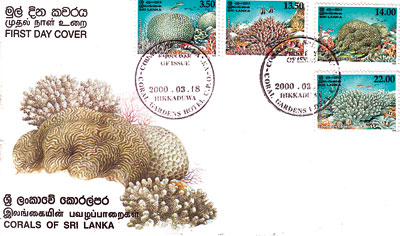Corals are fascinating objects which form the basic biological building blocks of our coral reefs. Coral reefs have been described as beautiful places of wonder, mystery, serenity and unmatched attraction that keeps one spellbound, making you soon forget the time
passing.
They represent the most diverse
ecosystems on our planet and have very rich
biological diversity.
They are often referred to as rainforests of the seas.
In an explanatory note on corals in the Stamp Bulletin which was
issued when the Philatelic Bureau released four stamps on 'Corals of
Sri Lanka' (March 18, 2000), Professor Suki Ekaratne – University of Colombo, says that although corals can be broadly divided into "hard" and "soft" corals, the term is usually used for hard corals which are "hard"
due to their limestone
skeletons.
The basic living
organism of all corals is a tiny simple animal called the coral polyp. Inside the coral polyps are live microscopic plant cells (an alga) called 'zooxanthellae'. These are very tiny plants which are able to
manufacture organic food by trapping the sun's energy. Most of the coral's nutrition is obtained from this food.
Coral polyps mostly live not singly but in colonies which are being formed by budding. Although each tiny polyp builds only its own tiny limestone cup
(a corallite) around itself, the numerous polyps of
the coral colony cement
their individual
limestone cups together into a larger structure.
These are cemented together by coralline algae to form the stronger reef framework. Corals with their skeletons making our reefs can therefore
withstand strong wave action and break the force of the waves before they hit and erode our shores. Coral reefs are also important habitats and nursery areas for fish and shellfish that supply the protein in our daily food.
It has been estimated that Sri Lankan coral reefs have around 180 species of corals in 68 genera. Their skeletons grow in various shapes that range from massive boulders, encrusting colonies, foliose colonies, plate-like forms to branched tree-like forms. In particular, branching and plate-like corals
provide numerous three
dimensional living areas for fish and other
organisms.
Four species found in shallow reefs of Sri Lanka are displayed in the set of four stamps and illustrate some of the variations which are classified as:
l Fevites flexuosa
l Acropora formosa
l Leptoria phrygia
l Pocillopora eyduxi
Commonly called
pineapple coral/larger star coral featured in the
Rs. 3.50 stamp, belongs to the Faviidane family which has the highest number
of genera among hard
corals. The colonies of fevites flexuosa are very different from the branched corals and are massive. They are
hemispherical or
sometimes flat.
The
surface of this domed colony has a honeycomb appearance where each depression marks the
position of a corallite which is separated from its
neighbour by a common limestone wall. It has a strong skeleton and is
common in shallow water habitats. It has a uniform dull grey, green or brown
colour.
Acropora – commonly known as stag horn or blue-tipped coral (Rs. 13.50 stamp) shows the greatest variety of growth forms of any coral genus containing all possible colony shapes. A Formosa forms bushy, highly branched tree-like colonies. It is one of the commonest corals in reef lagoons and some fringing reefs. It is usually brown or cream with creamish pale pink, blue or purple branch ends. The branches
resemble horns of a deer and grow to form dense thickets covering large areas. The skeleton is light, fragile and easily breakable. It is one of the fastest growing corals.
The brain coral (Leptoria Phrygia – Rs. 14 stamp)
is also common in
shallow water habitats. The colonies are massive with an even surface and dense skeleton that is sometimes formed of large lobes. The surface
appearance of the colony is similar to the surface of an animal brain. It has
several meandering canals or valleys. The living colony is cream, brown or green coloured with walls and valleys of a different colour.
The other is the elk-horn coral (Pocillopora eyduxi – Rs. 22 stamp) is also a branched coral which is similar in appearance to the stag-horn coral. But the colonies of this species lack a blue tip and have stouter, upright branches that may become flattened or paddle shaped in large colonies. It is light to dark brown or sometimes green. Branch tips can become white due to grazing
activity of the fish. It is also common in shallow reefs and one of the most surf-resistant corals.
Recent years have seen the coral reefs in the
Sri Lankan coast being
severely damaged mainly due to the tsunami in December 2004. Improper practices and over-use of coral reefs through coral mining, export of aquarium fishery, pollution,
dynamite fishing and high sedimentation have also led to the destruction of corals. Increased
temperatures can also damage the corals. |


